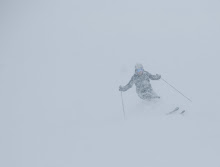The rock gym where I climb sets a new series of bouldering problems every month in ascending order of difficulty. Competitive types go to the gym on the first Friday night of the month and work on the problems, with other climbers and spectators encouraging them on and giving them "beta" (information). I'm told there is music with a strong beat and that it is lots of fun. My friends keep suggesting I go with them some Friday night, and my answer is "maybe after the ski season". Part of the reason why I haven't gone yet is that I am a competitive type and yet I am not confident in my climbing and bouldering when presented with a new series of problems. I also know that I am self conscious and suspect that the "beta" could be overwhelming for me.
I prefer to work on the problems a few days later, and that is what I did this past Monday night. I realized on Monday why there are called "problems" and how thinking ( which I often malign) actually helps solve them (doh!). I also realized that what I call thinking sometimes isn't thinking but a trick my mind plays on me.
There are rules for solving the problems. The first one is that you need to have two hands on the start and both feet on holds to begin. After that, you are allowed to use only the holds taped for the boulder problem number that you are solving. You can (unless specifically noted otherwise) use the features inherent in the climbing wall (corners, cracks, bumps, imperfections, etc...). Most people start out by looking at the problem and visualizing where and how they will put their hands and feet. Once they have visualized the first move, they begin a dance which is seen in crags and gyms. The dance is simply the climber standing at the bottom and putting their hands in the air, micmicking how they will move. Left hand up, right hand two inches to the right. left hand moves four inches, right hand matches on the same hold. Sometimes hips sway and legs move into a high step but hands dominate the dance. When I first started climbing, I would look at experienced climbers and wonder how they could develop such intricate patterns just from looking at the holds on the wall. It's taken two years, but I too now visualize the moves.
For example, I was looking at two problems at the upper end of my current climbing range. I looked at #11 and just didn't see a way. I looked at #12 and immediately pictured how I would move and what I would do. I was with a climber far more experienced than me and she doubted that I could do #12. She showed me how to do #11, but even with her beta, I just couldn't manage to take my right foot off a hold at the same time that I was reaching around the corner with my left hand. The problems are in increasing difficulty so theoretically #11 should have been easier for me than 12. But, we are all individuals, each with specific strengths. I tried #12 and fell off several times when I used the beta of my friend. I then decided to try it my way and climbed to the finish of the problem.
The success I had with bouldering problem #12 illustrates some key points. Belief that you can do it - I believed that I could do 12 but not 11, and my belief was borne out. My experiences in the corner where 12 is located have been more positive than in the door well where 11 is. This influenced my thoughts, positively in the case of 12 and negatively in the case of 11. As a result of this learning, I realized that I am not in the moment as much as I might be when I let an extraneous, irrelevant past event influence my current state of mind and action. This is a good point to be aware of as I move through bouldering problems and life. We are all different. What works for one person might not work for another. Individual variation is part of the beauty of climbing and life.
Subscribe to:
Post Comments (Atom)

2 comments:
Sometimes I look down a particularly hard run (for me) and envision a line I want to ski and the turns I want to make, this seems to work now and then. But some of my best runs seem to be those that I just skied without thinking about the run too much. Just letting go making quick decisions during the run and taking what comes. To do this I work hard on my skiing. When I’m on a course or in a session I visualize on the turn and its mechanics and very seldom do I actually enjoy the run. During the run I concentrate on just the turn and what I‘m trying to do in the turn and weather or not I achieved what I wanted to on the previous one. I do this when I practice my skiing too; it’s probably not unlike the bouldering problems presented at the climbing wall in your gym; they make you a better climber. I work on developing the technique or for the results because it makes me a better skier, to me that’s the fun part. Because, now I can just ski the run and let go
I agree with you, Dave, that some of the best runs are those that we ski without thinking too much. I've begun to use one word to focus on before I ski a run. Sometimes it's joy, sometimes balance, sometimes it's relax.
Post a Comment